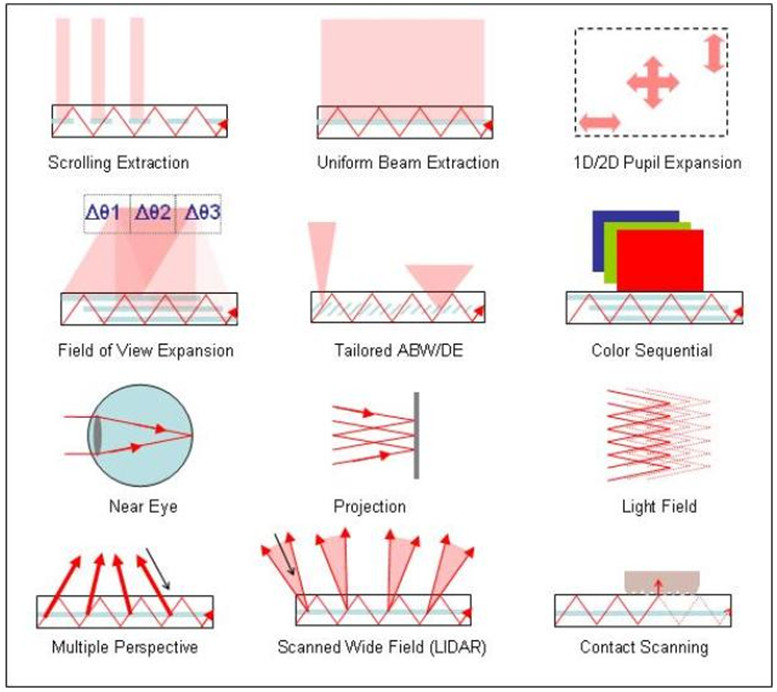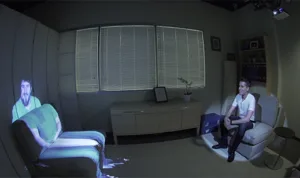Microsoft announced their Room2Room project that ups the typical Skype call to a full blown projection experience in a room. As the successor to an earlier project called RoomAlive, it uses the Kinect system in combination with a projector to bring the other person to life in the room. If anyone thinks “HoloDeck” right now, this is as close as we can get at the moment. There is no holographic projector involved or anything like that, just a plain projector.
Source: Microsoft
On the other hand this type of technology will get a big boost from other augmented reality solutions like AR glasses, that could accomplish the same thing in a much smaller form factor. You would have to wear the glasses though.
As reported in the Furniture News magazine, the opportunities of augmented reality technology in the furniture retail environment are growing as more and more companies are making use of this technology. To be clear, this has nothing to do with AR glasses, but with the underlying augmented reality technology inserting computer generated content into real world images. The most used platform here is the smartphone and tablet that allows the user to insert images of products into their home environment to figure out what works best. They mention Northern Lighting as a premium lighting fixture manufacturer that adds this capability as an app that picks up a chosen light fixture from a printed catalog and places it in a room at your residence.
This is not new, but shows that this kind of technology is pretty much the forefront of marketing tools for high end manufacturers. By these means, consumers are getting used to augmented reality as a useful tool rather than an awkward technology contraption I have to wear. Small steps but important to drive consumer adoption of the technology in the future.
The Motley Fool reports that Google is casting an eye over the VR market. As an example, they discuss the introduction of the Google Cardboard as an indicator for the initial interest from Google. While this could be seen as a ‘let’s take a look’ kind of approach, the rather substantial investment into Magic Leap that is developing new hardware and software solutions for the AR and/or VR space is much firmer evidence of the Google interest. Not that this kind of interest needs any kind of substantiating at all. VR may be a real big player in consumer electronics as a up and coming human machine interface in coming years, so how could Google afford to not look at it?
The latest news indicates that Google actually has a virtual reality team with Clay Bavor being named VP of VR. There is nothing else known about this department, however, Clay Bavor has been leading several groups developing consumer apps. It seems fair to say that he is a software guy by heart, which may provide a hint of Google’s interest in this field.
Another AR device shown is a development project from BMW, who added an augmented reality display to a motorcycle helmet creating a head up display solution for the motorcycle driver. A similar solution was already demonstrated by Skully which has such a product already on the market (The Perception of Motorcycle HUDs May be About to Change). The BMW solution is still a prototype, but includes a more advanced optical solution compared to the Skully AR-1. The BMW implementation includes a highly transparent planar waveguide, which allows for a relatively large field of view, even though BMW does not state any technical details in its press release.
 Digilens IP cores
Digilens IP cores
The planar waveguide comes from Digilens, a California-based company developing optical solutions for augmented reality devices. The waveguide is a key component needed to develop AR products with a small and slim form factor. The first design wins come from very specialized applications, although eventually the technology may also penetrate into the broader consumer market of AR glasses that cannot be distinguished from regular glasses or sunglasses. (Waveguide-based Displays Maturing for Augmented Reality Applications)
Analyst Comment
With VR inching closer and closer to the mass market introduction thanks to Facebook / Oculus we have to remind ourselves that it is certainly no the goal of Facebook to create a hardware device that revolutionizes the gamer’s computer interface. While it is by no means very likely that the Facebook execs are enjoying their video game once in a while, we have to recognize that this new human machine interface opens significant chances for social media apps to take the social on-line interaction to a new level. While this might seem a contradiction in terms, we have to recognize that Facebook, snapchat and the likes have completely changed ‘social’ interaction for the younger generation already. In their view, social interaction includes a constant stream of online contact without any person to person contact. Being without a data connection is like having a infectious disease several decades ago, being cut off from any social interaction.
At the same time, we are seeing a re-emergence of headsets that do not include any head tracking option. This is like the Zeiss Cinemizer, Sony 3D Viewer and several other devices. VR headsets like the Oculus Rift include head tracking that allows the user to turn and view content that varies with the viewing direction. It is exactly this interaction that creates in some users nausea based on pure head tracking and image lag. Some people are more prone to this bad experience than others. One of the possible reasons is the slight misalignment of the information from our eyes and the rest of our senses. I found it very difficult to walk down stair sin a virtual headset without moving my body, which of course can lead to some major injuries,a s their are no stairs to walk down. These devices without head tracking are no VR devices in the sense of Oculus, but more of monitor viewer (imagine you strap a tablet / monitor to your head without the issue of focusing on the display). This can be used for personal entertainment, but also for professional applications where the user needs to avoid the distractions of the environment and focus on the monitor to complete a task. So far this technology has not taken off as a mainstream consumer product. However, with the Oculus Rift being sold for $600, a $200 to $300 ‘monitor viewer’ may suddenly look like a much better deal. The right product at the right time will have some market success. (NH)

